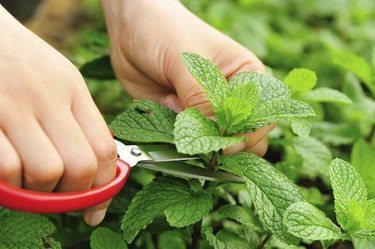
Whether you like peppermint (Mentha piperita L., USDA plant hardiness zones 5 to 9), spearmint (Mentha spicata, USDA plant hardiness zones 5 to 9) or both, you should know that bugs and other pests like them too. Nothing can ruin your plans for the perfect cup of mint tea or a relaxing mojito like mint pests. If you have bugs in your mint plant, there are ways to deter or remove them.
Common Mint Pests
Video of the Day
Insects and mites are both attracted to fragrant mint plants. One of the biggest fans is the peach aphid, which is small, soft and green, yellow, red, black, brown or pink. They excrete a sticky substance that can lead to sooty mold. Heavy infestations cause stunted shoots, dead spots and yellow leaves. Try pruning off the leaves, spraying them off with water or applying an insecticidal soap.
Video of the Day
Thrips are another kind of mint pest, and infestation symptoms include black speckled leaves and silvery or stippled leaves. Thrips are small and light yellow to brown in color. Reflective mulch can prevent infestations, but insecticide may be needed to get rid of them. Cutworms may be the problem if there are irregular holes in the leaves; they also leave larvae at plant bases. The larvae can be picked off (only after dark), and insecticides can also be used.
When the two-spotted spider mite infests mint plants, you can see webbing on the leaves, yellow or bronzed leaves or tiny dots moving on the underside of leaves and on the webs. Like other tiny invaders, mites are hard to see without a hand lens. You can spray them off with a strong stream of water or try an insecticidal soap.
Mint Plant Diseases
Insects and mites are not the only enemies of mint plants. There are several diseases to which these plants can succumb, such as mint rust. This fungus shows up with dusty, orange pustules that can turn yellow or black plus pale, distorted shoots and dead leaf tissue. There is no safe fungicide to use for the edible mint varieties, so it is best to remove the diseased plants.
Anthracnose, or "leopard spot," is another fungus that appears in brown, sunken spots on the lower part of the plant. This later morphs into oval lesions that have reddish-brown borders and gray centers. It is best to remove these plants as well since the spores spread easily.
The best way to avoid fungal growth is to keep the mint off the ground using cages or stakes. Mint should not be overwatered, and the area should be kept clear of debris. Check the plants often for signs of fungi or insects.
More About Mint Plants
There are about 20 species of Mentha, and these perennials have branching, erect stems and small leaves arranged on opposing sides. They sometimes have serrated margins, tiny hairs and white or purple flowers. Other varieties include chocolate mint, apple mint and ginger mint.
Mint can grow practically anywhere and should be planted after the threat of frost. The plants can be spaced 18 to 24 inches apart, but they can take over gardens, so you may want to grow your mint in a pot. These plants prefer consistently moist soil, so water the top inch when it feels dry.